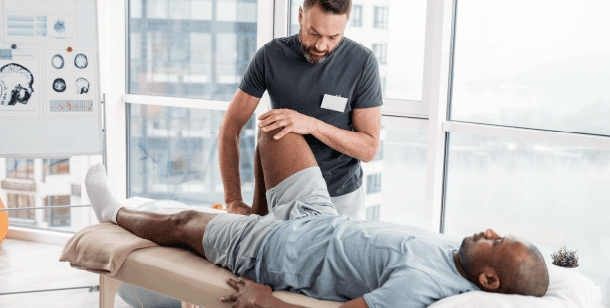Persistent knee pain can prevent people from living life to the fullest. If you suffer from dull, aching pain in one or both knees, there’s a chance that patellofemoral pain syndrome is the cause. In this article, we will learn more about this condition, its causes and symptoms, and how to treat patellofemoral pain syndrome.
What is Patellofemoral Pain Syndrome?
Patellofemoral pain syndrome is defined as pain at the front of the knee, under, or around the kneecap (patella). You may also know this condition by its more common names, “runner’s knee” or “jumper’s knee.”
This condition is common among athletes, active teens, older adults, and people who perform acts of physical labor on a consistent basis.
What Causes Patellofemoral Pain Syndrome?
Pain in the front of the knee, caused by patellofemoral pain syndrome, occurs when the cartilage in the patella becomes overloaded due to overuse or trauma.
This overuse often occurs when a person increases their physical activity levels faster than the knee can adapt to the new demands being placed on it. High-impact activities and poor alignment can trigger the pain and other symptoms associated with runner’s knee.
Patellofemoral pain syndrome can also be caused by weakness in the quadriceps muscles, repetitive stressful movements like those found in some sports and certain types of running or jumping activities.
Trauma to the knee that can result in patellofemoral pain syndrome can come from a fall, a severe sprain, or direct impact from a motor vehicle accident or similar incident.

Symptoms of Patellofemoral Pain Syndrome
Someone suffering from jumper’s knee may experience pain during the following situations:
- Climbing Stairs or Hills
- Playing a High-Impact Sport
- Squatting
- Walking on Uneven Surfaces
- When Performing Specific Exercises
Someone with this condition may also experience cracking and popping sounds coming from the knee, or notice that their knee pain is aggravated by activity but better after a period of rest. They may also experience pain after their knee has been bent for a long period of time.
How to Avoid Runner’s Knee
One can increase their chances of avoiding runner’s knee by doing the following:
- Maintain a healthy weight.
- Wear appropriate shoes for various activities.
- Take time to stretch and warm up before exercise.
- Gradually increase the intensity of workouts.
- Avoid knee threatening activities.
Why Diagnosis and Treatment is Important
Some people opt to ignore the root cause of their pain in favor of treating their symptoms. However, patellofemoral pain syndrome will not go away on its own and can cause negative, long-term health effects if it is not properly treated, in addition to causing day-to-day pain and inflammation.
To get a diagnosis of runner’s knee, your doctor will ask for your health history and may also ask about your lifestyle and activity levels. They will perform a litany of tests during a physical examination to diagnose your condition and to rule out other possible causes for your pain. These tests will evaluate the strength of your knee as well as its range of motion.
Medical imaging is not always helpful in diagnosing runner’s knee, but your doctor may ask for a CT scan, X-ray, or MRI to be taken.
At Home Remedies for Patellofemoral Pain Syndrome
It is possible to manage symptoms of this condition at home. You can take care of your injured knee by doing the following:
- Avoid keeping the knee in a bent position for extended periods of time.
- Avoid exercises that require you to bend your knee.
- Take anti-inflammatory drugs (NSAIDS) to decrease swelling, stiffness, and pain.
- Alternate between applying ice and heat to your injured knee to reduce swelling and help knee muscles relax.
- Allow your knee to rest.
- Wear knee braces as needed.

When is Professional Treatment Needed?
Now that we’ve discussed and learned how to treat patellofemoral pain syndrome, we have a better understanding of how to approach the medical condition. However, if the steps above are taken to care for your injured knee at home and after some time you are still experiencing swelling, stiffness, and pain in your knee, it may be time to reach out for professional medical help.
In many cases, physical therapy can provide great relief to people with patellofemoral pain syndrome. A physical therapist will walk you through exercises to help strengthen the muscles of your leg that support the knee. They will also perform stretching exercises to reduce tightness and help increase your flexibility and range of motion.
They may also recommend that you wear shoe inserts to help balance your stride and take undue pressure off of your injured knee and to reduce pain while exercising.
In extreme cases, when physical therapy has failed to provide relief, surgery may be necessary for removing damaged cartilage and tissue in the knee or properly realigning the patella. Your doctor will walk you through the details of whatever surgery they deem will best accomplish the goal of returning you to a life free of knee pain.
When to Find Your Village
When pain from runner’s knees becomes too much to deal with on your own, get help from the medical professionals you trust. Reaching out and exploring treatment options with your health care provider is the best way to treat patellofemoral pain syndrome and find relief from chronic knee pain. Get help today by reaching out to the Village behind you.
